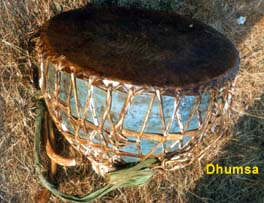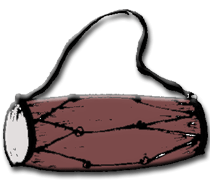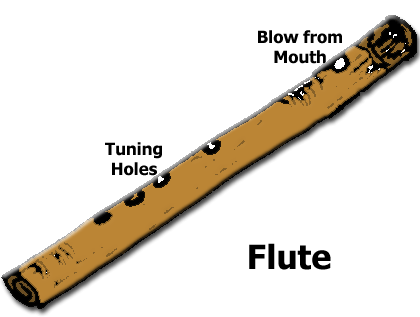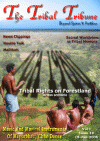|
Introduction
Music is a wonderful creation. It has no specific language. It expresses a common language. According to late Prime Minister Indira Gandhi, "Music itself is not merely sound, it is color and live, it is movement, it is pattern and design. It awakens feeling and at the same time has the capacity of express emotion... The religious person turns to music to evoke the right atmosphere for worship. The soldier needs a martial tune to dispel the fatigue of dreary marches. Old folk seek it as soothing balm for their nerves and the young to soak in their energy to cloak their shyness or to speak their love", (Menon 1994: Forward). Chho (Chhow) – essentially a ritual dance of Siva Gajan or Choitra Parav. It is exclusively found in some parts of eastern India, i.e. Saraikala-Kharsuan, East Singhbhum and West Singhbhum districts of Jharkhand, Purulia district of West Bengal and Mayurbhanj district of Orissa.
Though the use of vocal music is very rare in Chho dance, Jhumura folk song of the area has played an important and effective role to heighten the emotional impact of the dance (Mohapatra 1995:144-45). Jhumar songs inspire most of the tunes played on Mahuri in different stages of Chho dance. According to the Sirish Chandra Mohanta (1994-95), Jhumar is the heart beat of Mayurbhanj Chho dance and the Chho dance is the modern edition of Jhumar culture. To describe the interrelation between Jhumar and Chho dance Mahato (1991:35) writes, "Chhou dance and its music is very highly indebted to Jhumar for its over-whelming popularity". Similarly, to express the closeness of Jhumar and Chho dance Wallenstiner (1993:163) opines that "One strophe of a Jhumar is sung, but the noise around is tremendous. No sooner the Jhumar singer has finished his task Sahanai takes over the tune and modulates it in different ways."

From the above discussion it is clear that the Jhumar plays an important role in Chho dance. Various types of Jhumar music are composed for different types of dance items. Based on the styles of composition of these music items, Chho dance is broadly divided into following four groups.
(a)
Folk And Tribal Form:
Some of the dance items like Dhwajatal, Kalachakra, Tamundia Krushna etc. Chho dance is purely based on the folk and tribal forms of music of the area.
(b) Traditional Form:
| The dance items like Dandi, Kelakeluni, Madhurmilan; Nithurkalia, Odiya, Rasala etc. are basically composed on traditional oriya music like Odissi and Champu. Besides these traditional forms of oriya music, the application of oriya and folk music (mainly Jhumar) of Orissa and West Bengal in a hybrid form is also noticed in some (BalKrushna, Mahadev, Nataraj etc.) of the dance items. |

|
(c) Classical Form:
Ragas and Ragini of classical Hindusthani music play an important role in Mayurbhanj Chho dance. Many dance items like Kailashlila, Natraj, Geeta, Kirat, Arjun, Goruda, Holi etc. are composed on it. The Ragas like Malkhous, Bhairon, Sdarang, Bhageshree, Lait Vairabi, Jogiyaa, Kamaj, Bhinpalas, Desh, Ashobari etc. are basically used in the Chho dance.
(d) Mixture Form:
A mixture form of music from India and West is also presently noticed in the Chho dance. This mixture type of music is simultaneously used in some of the dance items like Taasa Nrutya and Desh Bidesh etc.
Besides, there is a special type of music - 'affect music’ composed for some specific dance items, which are inspired by the nature and the surrounding animal kingdom. This affect music is mainly based on the habits and habitats of animals.
Musical Instruments:
Like the two sides of a coin, Chho dance and musical instruments are interrelated to each other and therefore, the study of their relationship is fascinating and worth attempting. Without the presence of these typical folk musical instruments, simply one cannot be able to think or imagine about the Chho dance. Though modernization causes the introduction of Western musical instruments into the territory of Chho dance, it cannot be able to over-lap the traditional folk musical instruments like Dhumsa, Dhole, Mandal etc. Use of modern musical instruments in Mayurbhanj Chho dance as a subsidiary form is very sporadic and as a subsidiary form. To show the originality and to maintain the purity of Chho dance, the traditional folk musical instruments are being used by the Mayurbhanj Chho dancer rather than the modern Western musical instruments like Brass band, Western Drum, Trumpet, Keyboard, Cornet, Clarinet, Baritone, Saxophone and Piccolo etc. Depending upon the shape, size, material used and the technique of playing, these traditional musical instruments are divided into two categories namely, Anaddha (Percussion instrument) and Susuri (Wind instrument).
(a) Dhumsa:
| Dhumsa is on unifacial and almost conical shaped kettledrum possessing a narrow bottom and a very wide mouth at its top. Body of this musical instrument is prepared by connecting some pieces of thin iron sheets, which are of different sizes. The wide mouth portion of this musical instrument is covered either with a cow or a buffalo hide. The hide is hold taut by making a Pagri (plait) around its circumference and passing leather thongs through a set of holes made below the Pagri to the bottom of the drum. Technologically speaking, direct fixing of the leather to the body as said above and the plainness of the surface detracts from the instrument good musical and tonal values. (Prasad 1985:94) |
 |
On the basis of the size of the Dhumsa, it can be divided into two types, namely big and small. Both of these types are used for Chho dance. Generally, the bigger sized Dhumsa is kept on a Mancha, a four legged-wooden platform. Because of its huge size sometimes it is also placed on an open bullock cart for smooth playing. The smaller- sized Dhumsa is usually placed on the ground with the help of a small pedestal and as per convenience sometimes it also hangs from the neck of the musician. This typical musical instrument is always played with a set of long blunted sticks. Prior to beginning of Chho dance the player used to smash oil on the skin cover and warm it up by burning paddy stems for producing deep and attractive sound.
(b) Dhole:
| It is a principal and very popular accompanying musical instrument of Dhumsa. It produces both voluminous and delicate sound. It has a big cylindrical shaped hollow wooden body. Both the sides of this wooden body are covered with skins of cow. These skin covers are inter-connected and tighten with a long leather thread. This leather thread is coiled all around the wooden body of the Dhole and passes through a set of metallic rings. These rings are pushed towards the middle portion of wooden body to tighten its skin covers at its two heads and for stabilizing the produced sound. It hangs from the neck and placed on the waist or belly sidewise or straight of the player for smooth playing. Sometimes, player keeps it on the surface or on a small pedestal made out of paddy stems or cotton. One side of this Dhole is played with palm and fingers of left hand. The other side of the Dhole, which is covered comparatively with a thicker skin, is simultaneously beaten with an eight - ten inches hockey type stick having a blunted end held in his right hand. In special cases to produce a typical tune, player used to beat the wooden stick lightly along with the fingers of his left hand on the left-hand side of the Dhole. |
 |
(c) Mandal:
|

|
It is such type of musical instrument, which can be able to produce different tunes for Jhumar music played for Chho dance. It hangs over the left shoulder of the player and is beaten with the hands. It has a bifacial cylindrical earthen body. One end of this earthen body is slightly broader than its opposite end. A variety of sounds and tunes can be produced from different ports of these skin covers. For example, the center portion of the skin cover produces a different sound from its periphery. Except the special cases, the Mandalia (player of the Mandal) played the broader end with left and narrower end with his right hand. Like the Dhole, it also hangs from the neck of the player with some skin strips for smooth playing. Sometimes, a decorated colour piece of cloth or a towel is used to cover the upper half portion of the rounded body. The covers for its both ends are prepared either from the skin of cow, goat or monkey. Both the skin covers at its two ends are tightened and joined to each other with a long leather strip. The center portion of the skin cover at its narrower end possesses a rounded black coating Kharan. The Kharan is made from an Amalgam of grinded iron slag or brittle block stones and boiled rice etc. This Kharan at its broader end is prepared with a paste of grinded white stones and boiled rice. |
(d) Chadchadi:
|

|
This musical instrument possesses a short cylindrical body and is covered with a thin skin. Player hangs it on his shoulder in a semi-horizontal position and plays with the help of two lean sticks. |
(e) Sahanai:
Like the Dhole, Sahanai is also one of the principal accompanying musical instruments of Dhomsa, without blowing of which Chho dance can not be performed. Most of the tunes of Chho music are initiated on Sahanai and accompanied by Dhole, Chadchadi and Dhumsa. This Susuri group of wind musical instrument possesses a tubular shaped wooden body, a funnel, a hook, reed and a needle. The usual length of a full fitted Sahanai ranges between one to two feet. The body of the Sahanai is usually made from a lightweight fine dark black wood, which is slightly widened at its one end. It consists of six finer holes for six fingers (i.e. the fore, middle and ring fingers of both of the hands). By regular closing and opening of these holes with fingers, player controls the pressure of air inside the tube and produces different types of tunes. The funnel of the Sahanai is basically made from a bell metal or brass. The length of this funnel is about 1/3 to the total length of the Sahanai. The narrower end of the funnel is fitted with the broader end of the wooden body. The flared featureless rim of the funnel is served as an end of the Sahanai. This flared end of funnel is generally decorated with one to three regular incised marks on both of its internal and external surfaces. Two sets of reeds made from palm leaf along with a wooden needle are attached to the narrow blowing end of the Sahanai with small thread. Out of these two sets of reed, one set is fixed at the blowing end of the Sahanai and is adjusted with the wooden needles. Other set of reed is kept for emergency use.
(f) Vamsi:
| Vamsi is also one type of susuri group of musical instrument played for Chho dance. It is made from a long Baunsa / Vamsa (bamboo) having a thin wall, big cross-section and a long space between two nodes. Though the size and number of holes varies from Vaimsi to Vamsi, but the maximum number of Vamsi possesses seven holes. Out of these, six are meant for six fingers of two hands. These holes are drilled at one side of the Vamsi maintaining a regular distance between each of the holes. The rest one hole is blow hole, drilled on the same surface but on the opposite end of the finger holes. All these holes of a Vamsi are uniform in size. Like the Sahanai, Bansuria (player of Vamsi) uses his six fingers to produce different types of tunes for different stages of Chho dance. |
 |
|










